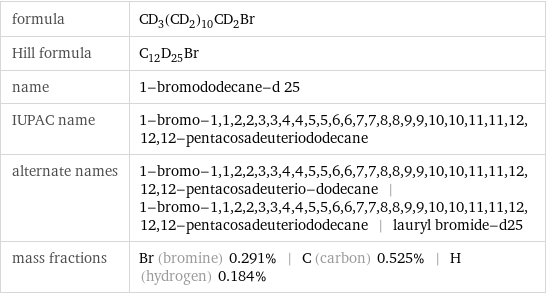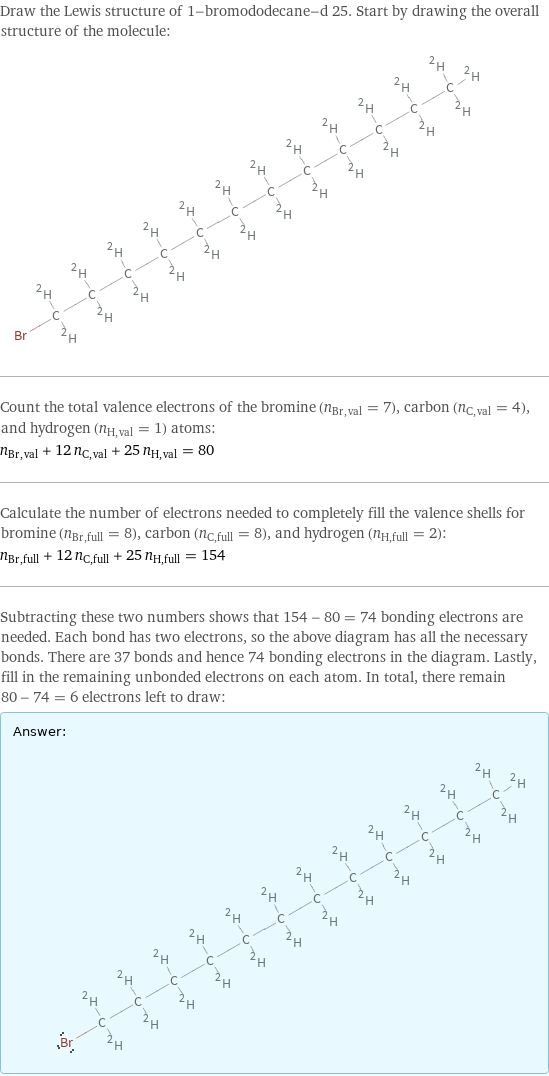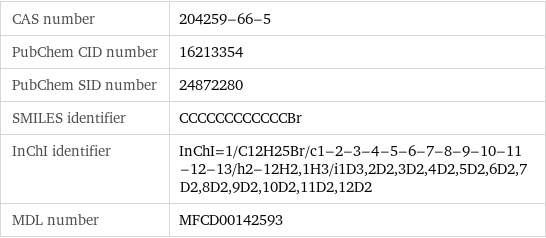Input interpretation

1-bromododecane-d 25
Chemical names and formulas

formula | CD_3(CD_2)_10CD_2Br Hill formula | C_12D_25Br name | 1-bromododecane-d 25 IUPAC name | 1-bromo-1, 1, 2, 2, 3, 3, 4, 4, 5, 5, 6, 6, 7, 7, 8, 8, 9, 9, 10, 10, 11, 11, 12, 12, 12-pentacosadeuteriododecane alternate names | 1-bromo-1, 1, 2, 2, 3, 3, 4, 4, 5, 5, 6, 6, 7, 7, 8, 8, 9, 9, 10, 10, 11, 11, 12, 12, 12-pentacosadeuterio-dodecane | 1-bromo-1, 1, 2, 2, 3, 3, 4, 4, 5, 5, 6, 6, 7, 7, 8, 8, 9, 9, 10, 10, 11, 11, 12, 12, 12-pentacosadeuteriododecane | lauryl bromide-d25 mass fractions | Br (bromine) 0.291% | C (carbon) 0.525% | H (hydrogen) 0.184%
Lewis structure

Draw the Lewis structure of 1-bromododecane-d 25. Start by drawing the overall structure of the molecule: Count the total valence electrons of the bromine (n_Br, val = 7), carbon (n_C, val = 4), and hydrogen (n_H, val = 1) atoms: n_Br, val + 12 n_C, val + 25 n_H, val = 80 Calculate the number of electrons needed to completely fill the valence shells for bromine (n_Br, full = 8), carbon (n_C, full = 8), and hydrogen (n_H, full = 2): n_Br, full + 12 n_C, full + 25 n_H, full = 154 Subtracting these two numbers shows that 154 - 80 = 74 bonding electrons are needed. Each bond has two electrons, so the above diagram has all the necessary bonds. There are 37 bonds and hence 74 bonding electrons in the diagram. Lastly, fill in the remaining unbonded electrons on each atom. In total, there remain 80 - 74 = 6 electrons left to draw: Answer: | |
3D structure

3D structure
Basic properties

molar mass | 274.39 g/mol phase | liquid (at STP) melting point | -10 °C boiling point | 134.5 °C (measured at 799.8 Pa) density | 1.141 g/cm^3
Units

Liquid properties (at STP)

density | 1.141 g/cm^3 refractive index | 1.458
Units

Non-standard atom properties

H-2 | 25
Chemical identifiers

CAS number | 204259-66-5 PubChem CID number | 16213354 PubChem SID number | 24872280 SMILES identifier | CCCCCCCCCCCCBr InChI identifier | InChI=1/C12H25Br/c1-2-3-4-5-6-7-8-9-10-11-12-13/h2-12H2, 1H3/i1D3, 2D2, 3D2, 4D2, 5D2, 6D2, 7D2, 8D2, 9D2, 10D2, 11D2, 12D2 MDL number | MFCD00142593
Safety properties

flash point | 110 °C